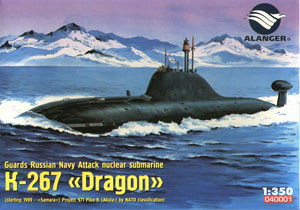Alanger 1/350 K-267 “Dragon” (NATO
Akula-I)
|
 |
Overview
The 971 Project submarine is the latest and most advanced Russian nuclear
submarine. Taking advantage of advancements in nuclear technology and
hull research, the resultant 971 submarines are exceptionally quiet without
sacrificing speed. Capable of speeds up to 35 knots underwater, it is
exceedingly hard to detect at speeds around eight to nine knots. Eight
torpedo tubes give this sub a potent offensive status, with the capability
of launching RK-55 “Granat” and “Vodopad” missiles
(NATO SS-N-21 “Pomegranate” and SS-N-16 “Waterfall,”
respectively). Although production has been slow, the 971 Project submarines
are likely to be in service with the Russian Navy for years to come.
The Kit
This is the first submarine kit from Alanger, and overall it looks like
they have done quite a nice job on it. Molded in black (or perhaps a very
dark gray) plastic, the kit features some petite detailing in places.
As most of the submarine is smooth, though, there is not much in the way
of surface detailing. There are no panel lines present, with the various
panels and hatches represented as raised sections. While this might present
a bit of visual variation on what is a generally bland and smooth surface,
a more accurate representation would have these as scribed line hatches.
As they are raised, though, it would not be too difficult at all to scribe
around them and sand down the raised sections. This might be a bit challenging
around the torpedo tubes and loading hatch on the bow, though.
 In
terms of actual construction, this is a very straightforward kit to build.
Out of the box, I would guess that this could be built and ready for paint
in a day, barring any major fit problems. A quick test fit of the upper
and lower hull reveals that fit problems are not likely here, too. Although
there are no locating pins, there are tabs to help keep the mating surfaces
aligned. A bit of careful alignment while gluing is all that is required
here. Before the hull is assembled, though, the instructions have you
make up some auxiliary power pieces. These are rather interesting, as
they look to be retractable. As they are well below the waterline, though,
I have been unable to verify their position, shape, or even their very
existence. As Alanger is based out of Russia, though, perhaps they have
much more information on this sub than is readily available in the West.
For those who do not want to mar the smooth lines of the hull can simply
glue the hatches closed for these. In
terms of actual construction, this is a very straightforward kit to build.
Out of the box, I would guess that this could be built and ready for paint
in a day, barring any major fit problems. A quick test fit of the upper
and lower hull reveals that fit problems are not likely here, too. Although
there are no locating pins, there are tabs to help keep the mating surfaces
aligned. A bit of careful alignment while gluing is all that is required
here. Before the hull is assembled, though, the instructions have you
make up some auxiliary power pieces. These are rather interesting, as
they look to be retractable. As they are well below the waterline, though,
I have been unable to verify their position, shape, or even their very
existence. As Alanger is based out of Russia, though, perhaps they have
much more information on this sub than is readily available in the West.
For those who do not want to mar the smooth lines of the hull can simply
glue the hatches closed for these.
Once the hull is together, the remaining assembly is quite simple. The
vertical fin, with its large towed array fairing, comes molded in two
pieces, while the lower fin is a single piece. A couple of small details
are mounted on the forward hull, ahead of the sail, and the remainder
of the assembly is contained to atop the sail. All the various antenna
hatches are open, with the appropriate equipment provided in the kit.
Aside from general cleanup, about all I would recommend here is to carefully
trim off the actual hatches and replace them with thin plastic card, as
the injection process leaves these pieces a bit thick. For those who do
not necessarily want to do that, some careful thinning with files and
sandpaper would work, too.
The decal sheet is somewhat large, which is surprising for a submarine
model. Normally the decals are minimal at best, but this sheet provides
quite a bit of hull markings. There is a thin white line at the waterline,
with the depth markings integral to these. Additionally, there are five
pieces of bow markings that consist of a bunch of connected rectangles.
I am not sure what these are for, but they are readily apparent in photos
and add that much more to the finished appearance. Finally, there are
the circular hatch markings, including the red and white rescue hatch.
This will add a bit of color to what is a pretty drab vessel (as most
submarines are). The decals are printed by Begemot and should present
no problems in application.
Conclusion
This is a great way to start a line of 1/350 submarines, and I thank
Alanger for producing this kit. A check on their website shows that they
have also just released a 1/350 Delta IV nuclear missile submarine, and
are planning a 1/350 Typhoon, so the line will be continuing with some
impressive Russian submarines. For those wanting to build a counterpart
to Dragon’s 1/350 Los Angeles class submarine, this is a perfect
kit for that. My thanks to Alanger
for the review sample. |
|
